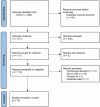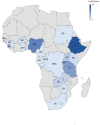Surgical site infections after caesarean section across sub-Sahara Africa: a scoping review of prevalence and associated factors
- PMID: 40666253
- PMCID: PMC12259575
- DOI: 10.3389/fgwh.2025.1605049
Surgical site infections after caesarean section across sub-Sahara Africa: a scoping review of prevalence and associated factors
Abstract
Surgical site infections are among the most common healthcare associated infections worldwide and pose a significant risk in cesarean section procedures, which are the most frequently performed surgical operations globally. Our scoping review aimed to synthesize available literature from studies conducted in sub-Saharan Africa on the prevalence of post-caesarean surgical site infections, as well as on reported associated factors. In this scoping review we included studies retrieved in OVID from January 2014 to January 15, 2024 without restrictions on the language of publication or publication status focusing on studies from sub-Saharan African countries. The review was registered on the Open Science Framework platform. The reported rates of surgical site infection across the 73 included studies ranged from 2.0%-56.0%. A forest plot showed that the studies were highly heterogeneous, whereby only 11.0% showed a surgical site infection rate above 20.0%. Most surgical site infections surfaced within two-weeks after a caesarean section. The strongest and most frequently cited risk factors were: duration of labour ≥8 h, surgical duration, multiple vaginal examinations, stored water usage, and premature rupture of membrane. The following protective factors were also determined: Pfannenstiel/transversal incisions, caesarean section at term, having health insurance, normal body mass index, <1 h of surgical intervention, <24 h of premature rupture of membrane, low intraoperative blood loss and absorbable sutures. Staphylococcus aureus was the most commonly isolated pathogen among studies with bacteriological reporting. Our scoping review provides first guidance for regions with limited resources for surveillance, such as sub-Saharan Africa, by outlining most common associated factors and a minimum screening period of two weeks. While utilizing minimal resources effectively, this targeted surveillance could capture the majority of cases and thereby enhancing maternal patient safety.
Systematic review registration: https://osf.io/qe7bf/.
Keywords: caesarean; scoping review; sub-Saharan Africa; surgical site infection; wound infection.
© 2025 Wood, Borodova, Wolter, N’Guessan, Diallo, Diallo, Heldt, Rocha, Nabé, Diané, Cherif and Müller.
Conflict of interest statement
The authors declare that the research was conducted in the absence of any commercial or financial relationships that could be construed as a potential conflict of interest.
Figures
References
-
- WHO. Protocol for Surgical Site Infection Surveillance with a Focus on Settings with Limited Resources. Geneva: World Health Organization; (2018).
Publication types
LinkOut - more resources
Full Text Sources




